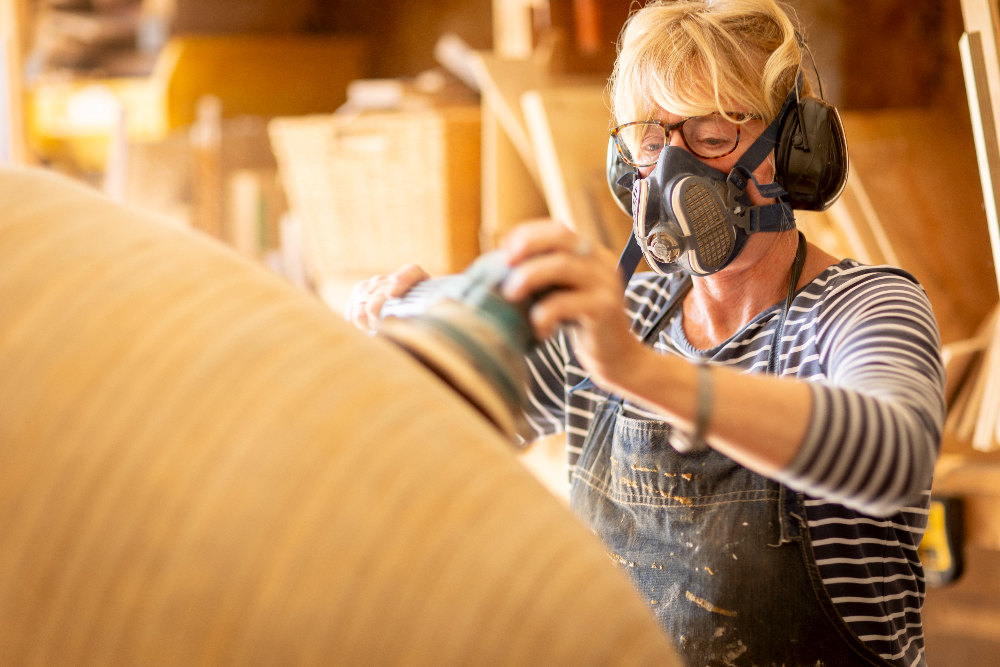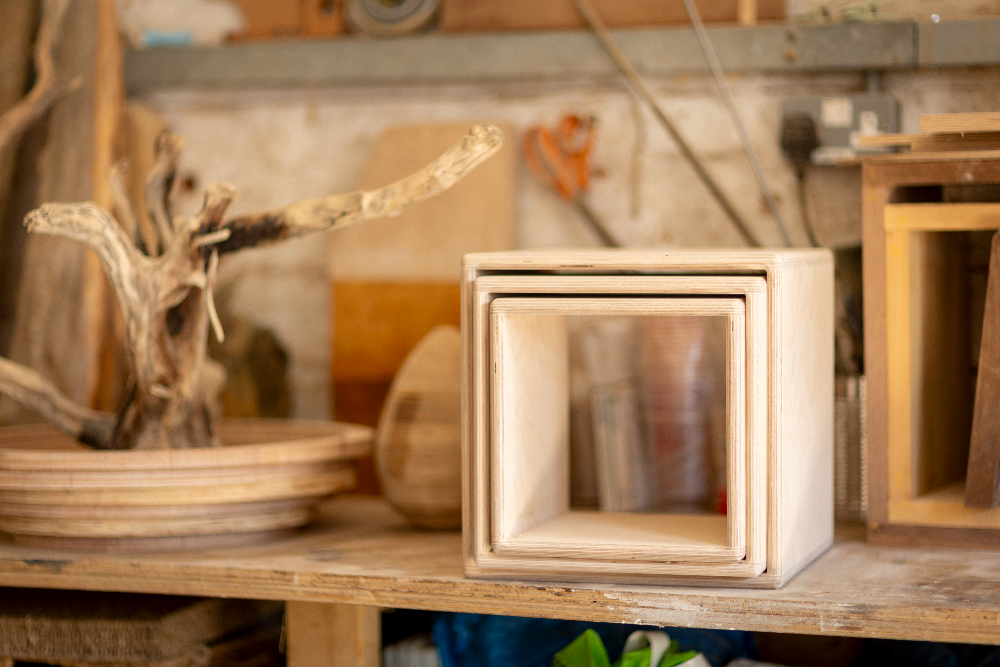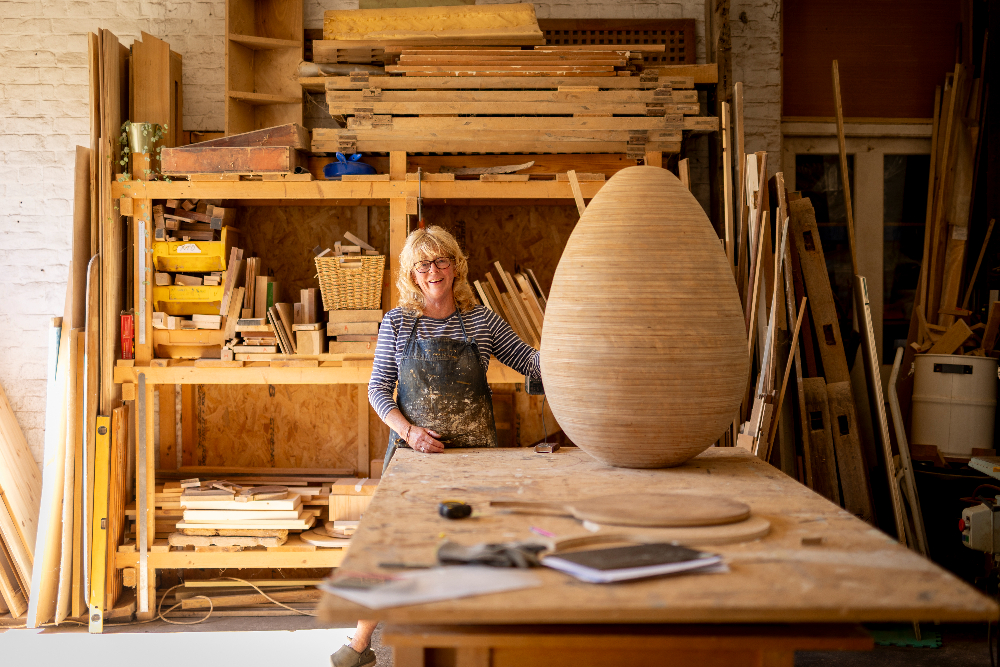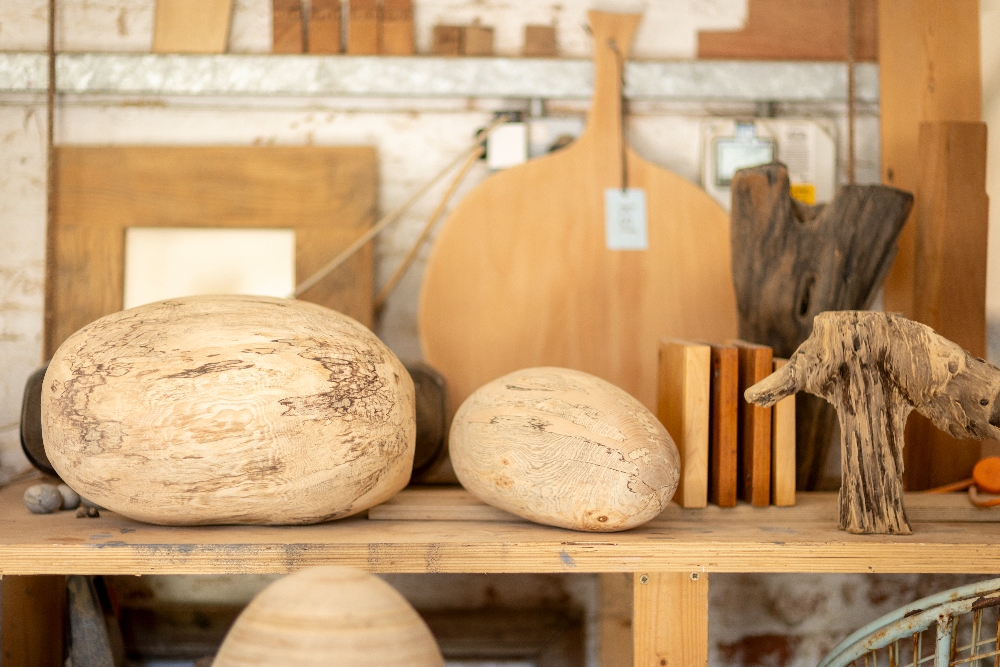This article first appeared in the September/October 2023 issue of Style of Wight magazine. Words by James Rayner. Photography by Julian Winslow.
On her days in the workshop, Kate Sanger leaves behind the breaking waves and circling seagulls of her home in Freshwater Bay and heads up the hill to a converted stone stable block at Norton Green, with her trusty dog by her side. After opening up, Kate looks over her part-constructed tables and newly sawn components, to see how her pieces have spent the night, before switching on the radio, whirring up the coffee machine, and reshuffling her notes — ready to begin a new day of woodwork.

Whilst today Kate looks very at home amongst the jigsaws, sanders, and sawdust, her career initially took off in a completely different direction. Born in Emsworth, to an architect father and a mother who did deskwork for a solicitor, Kate was often led away from creativity and instead nudged in a more academic direction. “I was definitely a bit of a tomboy,” she tells us, “and tried to help my father with his woodwork, but I think I got in the way more than anything.”
After growing up in Lymington, Kate settled on the idea of working in TV, though at the time one of the only routes in for women was via the make-up department. “I studied Theatrical and TV Make-Up at the London College of Fashion for two years, later working for Sky when they first set up in this country. I also did make-up for a lot of rock and pop bands at the time and whilst working for one particular TV company, I started making props too.”

Next came a move to an animation company and a first foray into set-making (spending months and months carving out a model cathedral) before enrolling in a furniture course at City and Islington College in 1995. “It was a course for women, run by women, with just one long-suffering male technician who would have to go around turning off all the machines that we’d left on. I finally felt like I’d found my place. At the time I was living with friends in Ladbroke Grove, which was much poorer and much more multi-racial than today. We used to have the Notting Hill Carnival go right past the door every year, which we’d all gather to watch, and then we’d be in and out of each other’s flats for drinks afterwards.”
The course ended with a final year at the London College of Furniture, after which Kate and two other students clubbed together to get their first workshop in Chiswick, close to the River Thames. Working under another company the group made interiors for bars and restaurants and even made lots of wooden boxes to raise up the floor in the National Theatre. “We were so quick and cheap we were always in high demand. The guy who ran the company told us it was far better using us efficient women than waiting for a bunch of men to turn up, just for them to begin by charging their drills.”

By the year 2000, a lot of Kate’s friends began moving out of London and, encouraged by a painter friend who had set up a workshop in Freshwater’s Golden Hill Fort, Kate headed down to the Island too — a place she knew well from childhood holidays. Leaving behind her commercial clients, she started to focus on crafting one-off pieces for individual customers, beginning with bespoke dining tables and a raft of stylish two-tone chopping boards, sold through Blue By The Sea in Yarmouth. As things took off, Kate moved from her first workshop in Freshwater to a metal container in a timberyard (“handy for the wood but the generator often didn’t work”), later switching to New Barn Farm at Calbourne and more recently taking over her former stone stable block at Norton Green. “Having been a metal workshop previously there were a lot of oily patches on the floor when I first moved in, but I love it; it’s my happy place and I’ve been here for five years now.”
From benches and cupboards to shelves and nests of tables, Kate’s reputation for crisp, finely crafted woodwork has spread entirely through word of mouth and her commissions continue to stretch her skills in new directions. Over the lockdowns, she made four tailor-made kitchens completely from scratch, sometimes with just a quick sketch to go by.
With every piece Kate sets to work on, ethics will always be high on the agenda. She sources sustainable temperate hardwood (such as oak, ash, and beech) and only ever uses reclaimed tropical woods, such as mahogany.

“I recycle and repurpose as much as I can. I once rescued some oak posts when they rebuilt the old walkway at Newtown and made them into a low chessboard table for a garden. I’ve also turned an old mahogany staircase into a garden bench and created some side tables out of old beams from Golden Hill Fort when they were converting it into housing. Judging by their enormous size, the trees must have been two hundred years old when they were felled and must have spent another one hundred years inside the fort. It feels wonderful to give the wood a new life again.”
Lately, Kate has also been revisiting sculptural woodwork and created a set of oversized, hollow wooden eggs, all five of which sold within days at James Lord’s Bath Road Gallery in Cowes. “At college, I did a lot of sculptural things and really enjoy shaping and blending. I used a computer program to work out the shape of each egg, then cut hoops of ply to the right diameters and glued them all together. Then to remove the pyramid-like steps between each layer I grind them off with my grinder to create a perfectly smooth surface. I’m sure the noise drives my neighbours mad, but I absolutely love the process.”
@kate_sanger_furniture
katesangerfurniture.com





